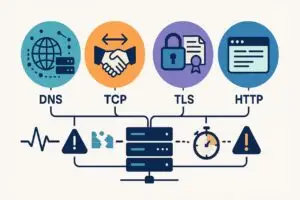
Synthetic Monitoring Frequency: Best Practices & Examples
How often should you run synthetic monitoring? Learn about synthetic monitoring frequency best practices, see implementation examples, and more.

Website Monitoring by Error Type: DNS, TCP, TLS, and HTTP
Learn how to monitor website errors by type. From DNS to TCP, TLS, and HTTP, see what each failure means and how monitoring reveals the root cause.

Synthetic Monitoring for Vibe Coded Apps: Why You Need It
Learn why vibe coded apps break differently, and how synthetic monitoring provides the uptime safety net they lack.

Landing Page Monitoring: Why, When and How to Do It Right
Learn why it’s critical to monitor landing pages for uptime and performance from multiple geographic locations. Read about best practices, tips, & more.

How to Monitor OTP-Protected Web Applications
Learn how to monitor OTP-protected web applications for uptime and performance. See why OTP monitoring is a must, and get tips on best practices & more!

How Synthetic Monitoring Can Warm Up Your CDN (and Why It Matters)
Synthetic monitoring helps you stay ahead of performance issues by proactively warming up CDN caches. Discover how to improve TTFB, cache hit ratios, and user experience.

Monitoring Behind the Great Firewall
A Technical SRE Analysis of Dotcom-Monitor’s China Capabilities

How to Monitor Login Pages for Performance and Security
Login pages are the front door to your website or application, and just like any front door, they need to be secure and easy to open. If your login page

Monitoring Distributed Systems
Monitoring distributed systems is essential to keep your system running smoothly, efficiently, and reliably. With the growing reliance on distributed systems in everything from web services to cloud computing and

Dotcom-Monitor’s Role in Ensuring SLA Compliance
When businesses promise their customers top-tier service, they often formalize these commitments in Service Level Agreements (SLAs). An SLA outlines performance standards such as uptime, response times, and issue resolution

Challenges in Monitoring Applications That Use OAuth
OAuth (Open Authorization) has become a critical component in enabling secure and third-party access to APIs which makes it one of the most widely adopted authentication protocols for modern applications.

How to Optimize Websites for Ad Publishers
Optimizing a website for ad publishers is a must for anyone that is looking to maximize ad revenue and improve their user experience. A fast, well-optimized website ensures better engagement,
